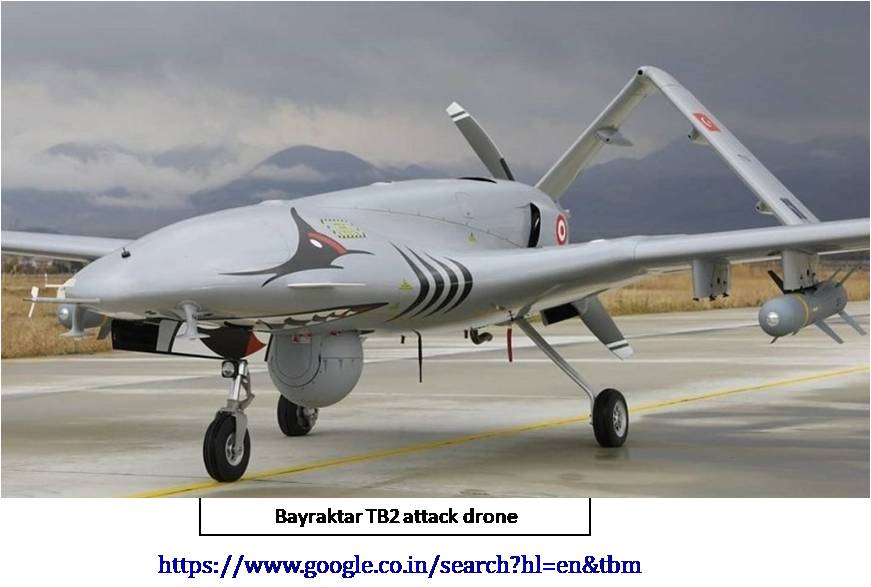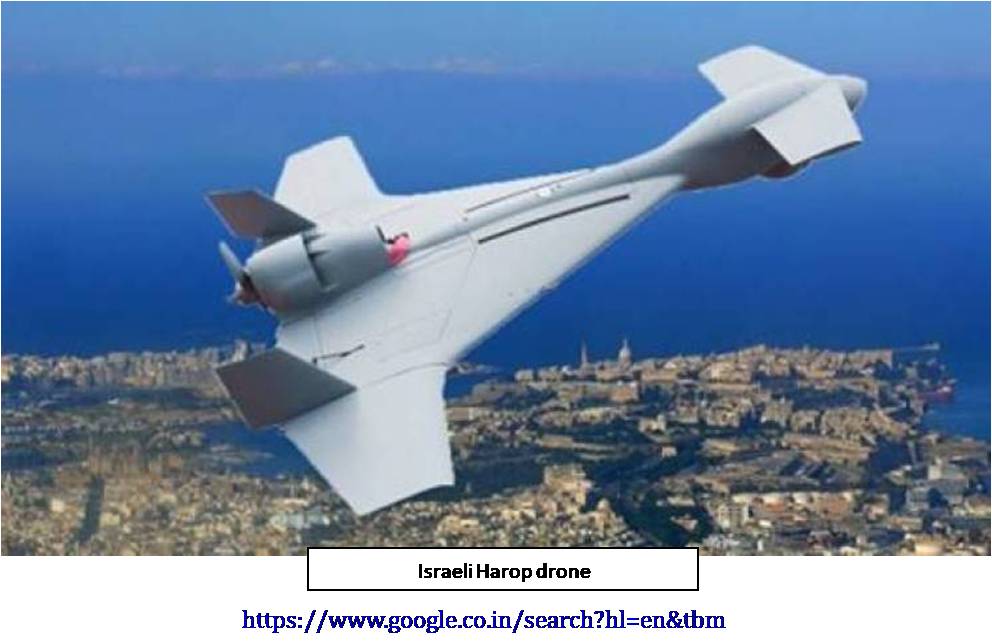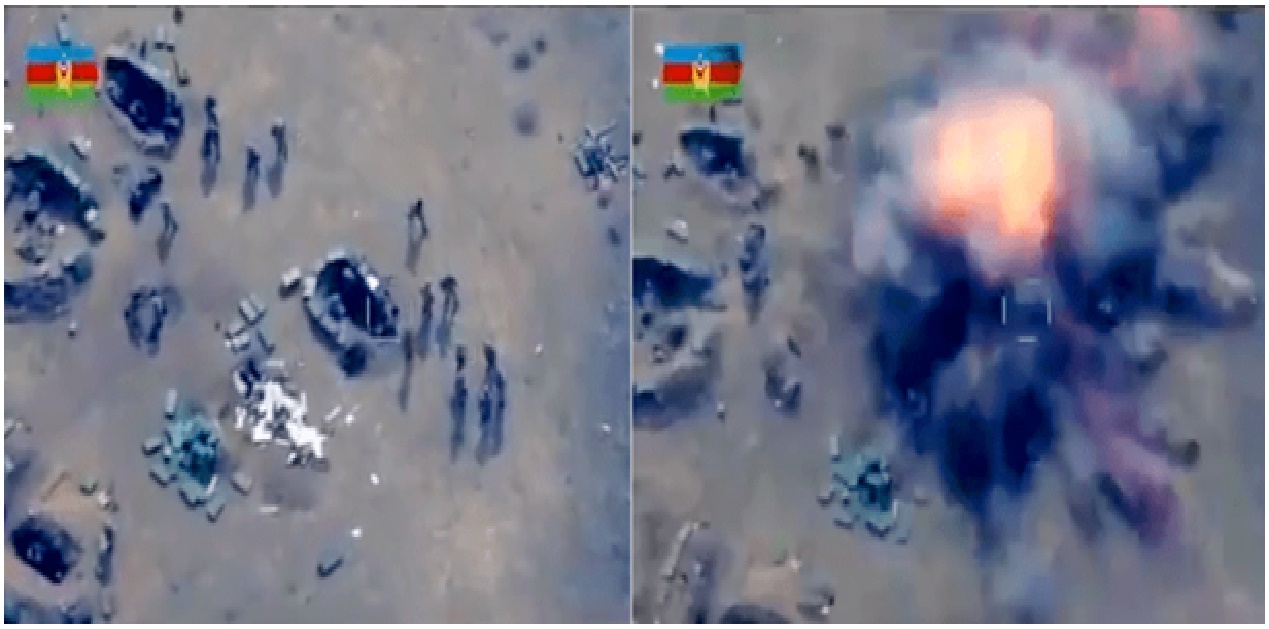Recently, the print and the audio-visual media were abuzz with the news of the Azerbaijan-Armenia conflict over the disputed lands of Nagorno-Karabkh. The blazing headlines and breaking news were telling some interesting facts on how the drones were causing havoc in the war.123
Drones on the Centre-stage
The central point being made in the news reports was that an unprecedented use of drone power by Azerbaijan brought them disproportionate success. This enabled them to forge a victory in this round of conflict which went in Armenia’s favour in the previous round in 1994.
This article attempts to provide an answer to the question contained in the caption.
Azerbaijan’s Drone Arsenal
- Azerbaijan mainly employed two types of drones. These are the Turkish Bayraktar TB2 and the Israeli Harop drone.
- Bayraktar TB2:-
- Bayraktar TB2 is MALE drone where MALE is an acronym that stands for a Medium Altitude Long Endurance Drones. MALE represents a class of drones that are capable of operating between 25000 to 50000 feet and have an endurance upto 24 hours. These are differentiated from HALE (High Altitude Long Endurance) drones that have capabilities higher than MALE (typical altitude ceiling – 60,000 ft or more, endurance 32 hours or more)4.
- In specifics, Bayraktar has an altitude ceiling of 27000 ft and endurance of 27 hours. It can carry a variety of armaments on its four hard points which include the following:-
- Long Range anti-tank missiles, L -UMTAS ( radio controlled, solid-fuelled, range 500m - 8 km with infra-red(IR)/laser based guidance and carrying as its teeth, the dual anti-armour warheads).
- MAM-C and MAM-L laser-guided munitions with precise accuracy (range 8-14 km, capable of taking on both stationary and moving targets). MAM-C is a typical High Explosive (HE) munitions whereas MAM L is a thermo baric munition. These type of munitions use the atmospheric oxygen to create a far longer blast wave producing greater lethal effect at the target than the conventional HE.
- Cirit laser-guided anti-armour and anti-personal missile. Range 1.5-8 km.
- Laser-guided rockets.
- For surveillance and target acquisition, Bayraktar is equipped with Active Electronic Scan Array (AESA) Radar. Such radars are state-of-the-art in radar technology. These are highly resistant to enemy’s jamming efforts, have a low probability of getting intercepted by enemy’s sensors, and have greater reliability and multi-mode capability5.
- Bayraktar has multiple options to home on to the targets. These include electro-optical, IR or laser-based homing.
- The Isreali Horop6
- Harop has loiter time of 6 hours in the battlefield. It has a speed of 417km/h, a range of 1000km. The drone has a very small radar cross-section (RCS) which is less than 0.5m2.
- It has two types of sensors to home on to its target:-
- One is an RF based sensor which can automatically home on to the Radio Frequency (RF) waves being emitted by an active sensor station like a fire control or missile guidance or an early warning radar.
- The other is an Electro-optics (EO) sensor which sends inputs about the static and moving targets located by it in the battlefield to its Ground Control Station (GCS). The operator at the GCS can then choose to command the drone to hit a chosen target. In this mode, Harop can take on a sensor/target which is not emitting anything (switched off) but recognised by the GCS operator as a target of choice.
- It has a single warhead of 23 kg which destroys/cripples the target in a catastrophic collision when the drone strikes it in the kamikaze (suicidal) mode. There is a very high probability of kill as the drone has an accuracy (measured as circular error of probability or CEP) of less than 1m.
- Equipped with Forward looking Infra-Red (FLIR) seeker and a Charged Coupled Device (CCD) camera, the drone is also an effective surveillance platform that provides real-time surveillance inputs to its GCS.
- Upon command or in case of a mission-abort, the drone has a capability to return to its base.


The Harop drone made by Israel Aerospace Industries is actually a drone that can lay in wait (loiter) over the battlefield and on opportunity, can strike its target riding on the radiations emitted by such a target. Some points about Harop are as under:-
RCS is a measure which indicates the detectability of an object by radar. Higher the RCS of an object, greater will be its probability of detection by radar. An RCS of 0.5m2 is considered to be very small, implying that Harop cannot be easily picked up by radar. RCS of typical combat aircrafts is 2-3m2. (F16 -5m2, F16-C 1.2m2)
Armenian Losses in War
Open sources have recounted crippling losses for Armenia which actually forced them to accept the Russian brokered ceasefire and return much of the gains made in the previous conflict.
Very briefly, the Armenian losses as recorded in various reports include some 2500 military personnel, 100 tanks, 100 artillery weapons, 60 air defence systems that includes one S -300 sensor system, 11 command and control stations. Besides this, many civilian casualties and losses to civilian infrastructure have been reported in the cities of Ganja, Barda, Stepanakert and Susha in the disputed Naorno-Karabakh area. (Azerbaijani losses not listed but are similar though a shade less).
Armenian Air Defence Resources
The air defence force in Armenia comes under the overall control of Armenian Air Force. Some salient points about Armenian air defence are enumerated:-
- The air defence is based on self-propelled guns and surface-to-air –missiles (SAMs) with a heavy bias on the later.
- The self-propelled guns include the Russian origin Schilka weapon system. Though Schilka is of 1960s vintage but it is still going strong in many armies of the world including India (albeit with suitable upgrades). The weapon, configured on a tank chassis has four radar controlled auto cannons of 23 mm calibre. It has a rate of fire of 3400 rounds per minute and a range of 2.5 km.
- The missile force consists of the following:-
- Strela 10M very short range SAM system. Range 5km, altitude ceiling 11,500 km.
- OSA -AK very short range SAM system of seventies vintage. Range 10 km, altitude ceiling 15000 ft.
- SAM 6 (2K12Kub) Kvadrat weapon system of the Yom Kippur fame. Kvadrat is also of 1967 technology vintage. It is a medium range SAM (MRSAM) system with an operational range of 24 km and altitude ceiling of 20,000 ft.
- Buk M2 MRSAM system. Range 30 Km, altitude ceiling 46000 ft. This is a relatively later vintage weapon system of around 2010 or thereabout. In many ways it is considered to be a successor of SAM 6 system and has many improved features (not covered).
- Upgraded Pechora old vintage (sixties) short range SAM system Range 35 km, altitude ceiling 59000 ft.
- S-300 PM long range (40-350 Km) SAM and anti-ballistic missile defence system.
- Old vintage (1965) SA-4 Ganef MRSAM system. Range 55 Km, altitude ceiling 80,400 ft.
Some Observations on Armenian Air Defence Force
Following points are observed:-
- The inventory is almost entirely based on SAMs with some holdings of 23 mm self-propelled and towed guns.
- Except for Buk M2 and probably OSA (upgraded), most of the weapon systems are of very old vintage and technology dating back from sixties to about 2010.
- The guns and SAMs together cover a range bracket from 2.5 km to about 55 km and an altitude bracket from a few thousand feet to 80,000+ ft. Apart from this there is a stand-alone S 300 long range SAM and BMD system.
A Word on the Anti-drone Arsenal
Another point very conspicuous to note is the near absence of anti-drone weapons in the arsenal of the Armenian air defence forces. Following points are made as regards anti-drone arsenal:-
- Drones throw two challenges to conventional air defences:-
- Their RCS is generally too small to get detected by conventional air defence radars be it early warning, fire control or missile guidance radars.
- Being extremely low-cost, these demand low cost kill means. There is no point of killing a few hundred dollars drone with a million dollar missile. This ratio becomes further skewed if the opponent is a swarm drone, off which the best of SAMs worth millions can take out only a few.
Keeping the above two challenges in mind the defenders have come up with the following anti-drone solutions:-
- Dealing with the detection Challenge.
- Though small RCS drone detection remains a challenge for the radars, the AESA radars have shown promising results. In such radars the reflected radio beam can be steered electronically in different directions without the physical movement of the antenna. Though this is not the radar feature that aids small RCS detection, it makes the radar highly responsive.
- In fact, these high technology machines have the state-of-the-art solid state trans-receive modules and generally possess high sensitivity and high resolution (sensitivity means minimum strength of the target signal required for detection and resolution is the ability of a radar to distinguish between targets that are close to each other). This aids in detection of small-RCS objects like a drone.
- It has been the experience that drone detection radar are small dedicated machines working in mid frequency bands C, X, Ku, K ( 6-15 GHZ) where high resolution and precise detection is possible (radar frequency bands range from HF-J spanning from 0.2 GHZ to 300 GHZ). Normally these machines are frequency modulated continuous wave (FMCW) radars (not explained further).
- More successful drone detectors than the radars are Electro-Optical (EO) devices. An EO device will basically consist of a daylight CCD camera, a thermal/IR night camera and a computing/processing device.
Since most of the drone-warfare is executed in the visual domain, such devices actually record the 3D dynamic image of the drone in flight and present it to the user to identify it as a flying object against a threshold background called clutter/noise.
Optical devices based on latest techniques (for instance laser-gated-viewing etc. – not explained further) increase object-to- background contrast and help detect a drone. Once detected the electronics of the EO device keeps the target under surveillance and then enables the ‘kill means’ (described later) to execute the end-game.
D. In some cases the EO devices are also assisted by acoustic detection systems (details not covered).
- Kill Systems
- The kinetic kill solutions (earlier vintage) involve a kinetic payload directed at the drone which attempts to kill it by achieving a catastrophic collision.
- The RF kill solutions direct RF beams on to the attacking drones which attempt to jam/disable/destroy the communication link between the drone and GCS. Normally this link is a line of sight radio link in the Military C band 500-1000 MHz or satellite communication in the KU band between 10.95-14.5 GHz. (uplink band to satellite is normally 13.75-14.5 GHz and the down-link from the satellite is normally10.95-12.75 GHz).
- The electronic kill is a broad category that includes all forms of electronic and laser attacks on the drone that are aimed to disable its sensing/navigating and tracking capabilities. It also works for such drones that are not GCS-dependent but have dedicated navigation and tracking systems on board such as the Bayractar drone.
To detect millimetric-RCS drones there is a requirement of specialist radars. Some points about these radars are covered:-
Drone kill systems are the ones that ‘kill pennies with pennies’. Low cost, bulk fire is their signature. The drone kill system basically span three domains, namely, the kinetic kill, the RF kill and the Electronic kill:-
Another variety of kinetic kill is to deliver high rate and volume of fire from ground based weapons. It could range from a machine gun to low calibre high rate-of-fire air defence guns (3000-10,000 rounds per minute).
Once this link is disrupted the drone becomes blind and rudderless. It flies around till it crashes or is out of fuel. It loses its capability to be directed to the target.
A Word on Armenian ADCRS System
Air defence weapons do not fire as stand-alone pieces. These are threaded together into a co-ordinated loop by what is called an Air Defence Control and Reporting System or ADCRS for short. ADCRS is the life-line of the air defence battle. It is responsible for a host of battle functions that ensure an optimal and a coordinated battle function.
The functions handled by ADCRS include carrying out surveillance of air space to build the air situation picture (ASP), identification of threat vehicles in the ASP thus generating a Recognised Air Situation Picture ( RASP), prioritising the threat, selection of the most suitable weapon to take on the threat, designation of the target to the chosen weapon, shifting the fire from weapon -to-weapon in a seamless manner, and finally exercising minute-to-minute control on the ensuing air defence battle. In a typical episode of an air defence battle all these battle functions get executed in a matter of few fleeting minutes.
While inadequate details are available in the open source on the Armenian ADCRS system an analysis of the live videos streamed endlessly from both sides does reveal a conspicuous absence of an effective ADCRS on both sides. The Armenian Schilkas, guns and a few SAMs are seen firing in an ad hoc and a stand-alone manner rather than in a planned and seamless manner with fire shifting from weapon-to-weapon. In many videos, the air defence radars of various types (probably associated with various SAM systems ) are seen on the cross wires of the Bayractar or Harop drones and finally getting destroyed without them delivering lethal fire on the slow moving attacking vehicles.
Reflections
Putting all the above together, it becomes clear why the Azerbaijani drones played havoc into Armenia. Following points are stated:-
- Armenia’s old/mid vintage ground based air defence weapon systems did not have the type of sensors as are required to detect small-RCS drones.
- In fact, most of the old vintage SAMs actually had such sensors that emit high volume of RF waves (Pechoras, Buk 2M, S-300 and more). These sensors could have been easily picked up by Bayractar, as well as Harop drones.
- Most conspicuously, the Armenian ADCRS system was either not there or not seen to be operating as it should have. Some air defence SAMs and guns were seen huddling along or deployed as single units and trying to fire at the drones. There was no semblance of a coordinated air defence battle. At least the same was not seen to be unfolding.
- Leave air defence weapons, even the move of tanks and artillery pieces was so non-tactical that it prodded some experts to reach a conclusion that with the advent of drones, the days of tank warfare are numbered!
- While the above is far from truth (not discussed further), there is no doubt that if drones are allowed to have their way in ‘uncontested skies’, these can indeed play a havoc into their opponent.
- On the flip side faced with a resolute defender who is equipped with the requisite anti-drone arsenal, these little devils cannot inflict such tremendous losses which in their ultimate count from all weapons accounted for a whopping 100 tanks, 100 artillery weapons, 60 air defence systems and one S -300 sensor.
And finally while an unmanned weapon like a drone may become an ATTACKER’S DELIGHT, it cannot become a DEFENDER’S NIGHMARE, provided the latter is equipped with the type of sensors and shooters that can kill ‘pennies with pennies’. Faced with such defenders, this little wonders cannot claim disproportionate kills as it happened in the battlegrounds of Nagorno-Karabkh.
The reader now has an answer to the question in the caption.
Endnotes
- “Azerbaijan-Armenia war throws up fascinating military drone use…,” at www.defence.capital. Accessed on 24 Nov 2020.
- Drones won the war for Azerbaijan..,”atwww.theprint.in. Accessed on 24 Nov 2020.
- In Nagorno-Karabkh, the future of warfare is now…,”at www.rferl.org.Accessed on 24 Nov 2020.
- “Future of unmanned capabilities: MALE vs HALE” , at www.defensesystems.com. Accessed on 25 Nov 2020.
- “Understanding AESA…”at wwwblog.billiey.com. Accessed on 25 Nov 2020.
- “Harop Loitering Munitions…,”at www.airforce-technology.com.Accessed on 25 Nov 2020.
(The paper is the author’s individual scholastic articulation. The author certifies that the article/paper is original in content, unpublished and it has not been submitted for publication/web upload elsewhere, and that the facts and figures quoted are duly referenced, as needed, and are believed to be correct). (The paper does not necessarily represent the organisational stance... More >>
Image Source: https://sofrep.com/news/armenian-azerbaijani-drone-strike-footage-graphic/









Very nicely written
Post new comment